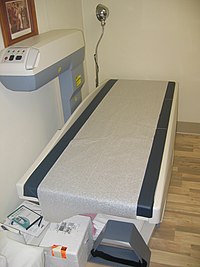
Photo from wikipedia
Objective To explore the risk factors for nonalcoholic fatty liver disease (NAFLD) in postmenopausal women with type 2 diabetes mellitus (T2DM) and the correlation with bone mineral density (BMD) in… Click to show full abstract
Objective To explore the risk factors for nonalcoholic fatty liver disease (NAFLD) in postmenopausal women with type 2 diabetes mellitus (T2DM) and the correlation with bone mineral density (BMD) in different areas of the body. Methods A total of 434 postmenopausal women with T2DM were enrolled and categorized as 198 patients in the NAFLD group and 236 patients in the non-NAFLD group based on color Doppler ultrasound of the liver. The BMD of the lumbar spine, femoral neck, and total hip were measured by dual-energy X-ray absorptiometry. Results In postmenopausal women with T2DM, the prevalence of NAFLD was 45.6%. The body mass index (BMI), systolic blood pressure (SBP), glycosylated hemoglobin (HbA1c), alanine aminotransferase (ALT), aspartate aminotransferase (AST), gamma-glutamyl transpeptidase (GGT), triacylglycerol (TG), uric acid (UA), and homeostatic model assessment for insulin resistance (HOMA-IR) C-peptide (CP) were significantly higher in the NAFLD group than in the non-NFALD group, and the duration of diabetes, and high-density lipoprotein cholesterol (HDL-C) were lower than in the non-NAFLD group (P < 0.05). Logistic regression analysis revealed that BMI (odds ratio [OR] = 1.303, 95% confidence interval [CI]: 1.152–1.346), HbA1c (OR = 1.263, 95% CI: 1.095–1.392), TG (OR = 1.263, 95% CI: 1.031–1.601), and SUA (OR = 1.005, 95% CI: 1.001–1.007) were correlated with NAFLD (P < 0.05). The BMD of the total hip and femoral neck in the NAFLD group was higher than in the non-NAFLD group (P < 0.05). Conclusion Complicated NAFLD in postmenopausal women with T2DM is associated with weight gain, poor blood glucose control, abnormal lipid metabolism, and elevated UA levels. In addition, the NAFLD group had higher femoral neck and total hip BMD than the non-NAFLD group, suggesting NAFLD in postmenopausal women with T2DM may reduce the risk of osteoporosis.
Journal Title: Diabetes, Metabolic Syndrome and Obesity: Targets and Therapy
Year Published: 2022
Link to full text (if available)
Share on Social Media: Sign Up to like & get
recommendations!